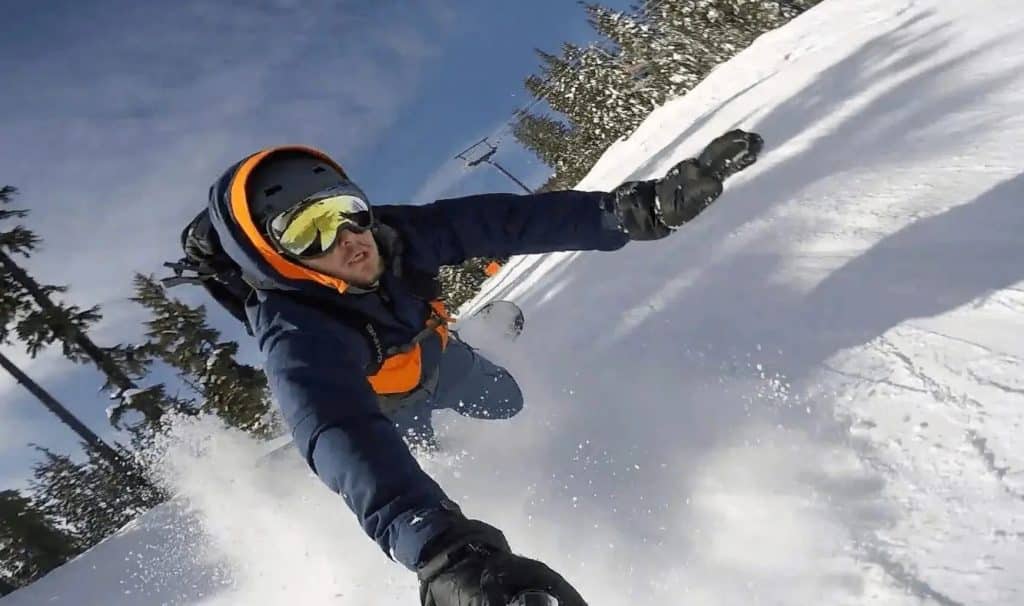Knee pain is one of the most common complaints I see in snowboarders. I’ve worn both hats as an instructor and a physical therapist, and trust me, I’ve heard “my knees are killing me” more times than I can count.
The good news is most of the time it’s not something you’re stuck with. A few tweaks to your strength, technique, or setup can make a huge difference.
Here are the big reasons your knees might be aching after a day on the hill and what to do about them.
1. Weak Supporting Muscles
Snowboarding relies on your whole lower body working together. Quads, hamstrings, glutes, hips. If those muscles aren’t pulling their weight, your knees end up doing more work than they should.
Fix: Strength training off the hill is your best friend. Squats, lunges, hamstring curls, hip thrusts, and side steps with a band are all solid. Stronger legs take the pressure off your knees.
I also highly recommend a snowboard balance board. Trains both your technique and your muscles. Which brings me onto my next point…

2. Sloppy Technique
A lot of knee pain comes down to form. Common mistakes I see:
Landing stiff instead of bending knees, hips and ankles to absorb shock
Twisting awkwardly on turns – strains the ligaments
Locking your legs out and pounding your joints into every bump
Fix: Ride smooth and relaxed. Bend through all three joints and focus on absorbing terrain instead of fighting it. If you’re not sure what you’re doing wrong, take a lesson. Sometimes all it takes is a fresh set of eyes to spot the habits that are hurting your knees.
3. Gear That Doesn’t Fit
This one gets overlooked but it matters a lot. Bad gear creates bad biomechanics.
Boots that are too soft or too loose let your knees wobble around
Bindings set at the wrong width or angle force your joints into unnatural positions
Fix: Get boots that fit properly and experiment with your stance. Small changes to your binding angles can make a huge difference. If you’re not sure, head to a shop that knows what they’re doing and get set up right. Aftermarket insoles also help. More than you might think.
4. Overuse and Fatigue
Snowboarding hammers your legs. If you ride too much without recovery your knees will let you know.
Fix: Pace yourself. Build up gradually, take breaks during the day, and schedule actual rest days. A little pacing now keeps you riding longer and harder.
5. Old Injuries or Just Mileage
If you’ve blown out a knee before or you’re dealing with arthritis, your joints will always be a bit more vulnerable. That doesn’t mean you can’t ride, but it does mean you need to be smarter about how you do it.

Fix: Prioritize strengthening and stretching. Consider bracing or compression sleeves for extra support. And seriously, knee pads. If you haven’t already, check out my post on the best snowboard knee pads. They’ve saved me (and plenty of my students) from turning a small slam into a big problem.
6. Warm Up Before You Ride
Most riders skip it, but a quick warm up before strapping in can make a huge difference for your knees. It gets blood flowing, wakes up your muscles, and helps absorb impact when you start riding. You don’t need a gym routine — just a couple of minutes in the parking lot is enough.
Quick Pre-Ride Knee Saver
- 10 bodyweight squats
- 10 walking lunges (each side)
- 10 hip bridges
- 20 seconds of side steps with or without a band
Two minutes of this and your knees will feel way better once you’re on snow.
7. Know When to Stop
Riders are stubborn. I get it. I’ve pushed through plenty of days when my body was screaming at me to quit. But there’s a difference between normal muscle fatigue and something more serious. If your knees are swelling, locking up, or giving way, that’s not just soreness. That’s your body waving a big red flag.
Fix: Don’t just strap in and hope for the best. That’s the time to step back, rest, or get it checked out. Riding through real pain doesn’t make you tough. It makes the injury worse and the recovery longer.
8. Keep It Fun
At the end of the day, this isn’t about workouts or gear tweaks — it’s about getting more good days on snow. Strong, happy knees mean more powder mornings, more park laps, and more seasons ahead without sitting on the sidelines. That’s the whole point.

Bottom Line
Knee pain doesn’t have to be part of snowboarding. With stronger muscles, better technique, the right gear and proper rest, you can keep riding without limping back to the car.
And if you’re still unsure about knee pads, don’t be. They’re one of the simplest ways to keep your knees safe and pain-free.
